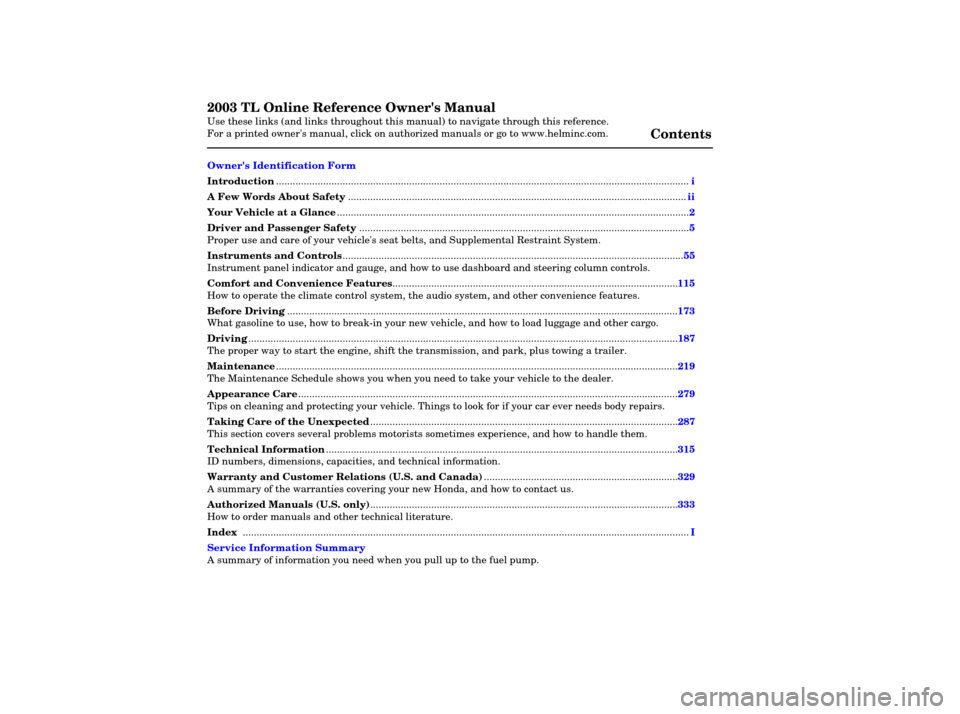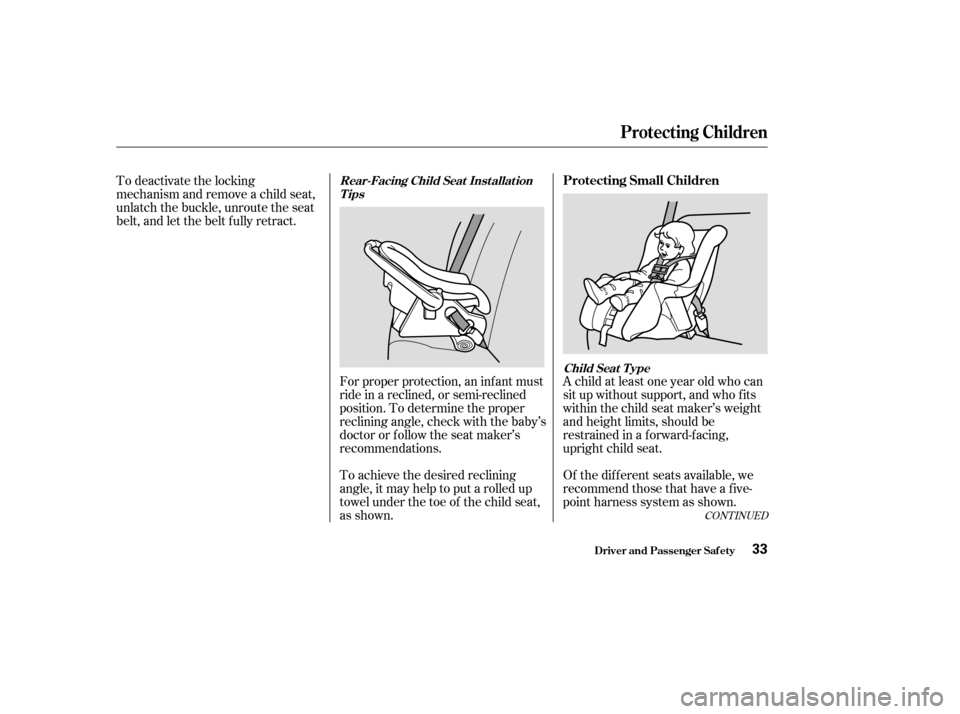tow Acura TL 2003 3.2 Owner's Manual
[x] Cancel search | Manufacturer: ACURA, Model Year: 2003, Model line: TL, Model: Acura TL 2003Pages: 347, PDF Size: 4.14 MB
Page 1 of 347

2003 TL Online Reference Owner's Manual Use these links (and links throughout this manual) to navigate through this reference.
For a printed owner's manual, click on authorized manuals or go to www.helminc.com.
Contents
Owner's Identification Form
Introduction ........................................................................\
............................................................................. i
A Few Words About Safety ........................................................................\
.................................................. ii
Your Vehicle at a Glance ........................................................................\
....................................................... 2
Driver and Passenger Safety ........................................................................\
............................................... 5
Proper use and care of your vehicle's seat belts, and Supplemental Restraint System.
Instruments and Controls........................................................................\
...................................................55
Instrument panel indica tor and gauge, and how to use dashboard and steering column controls.
Comfort and Convenience Features........................................................................\
............................... 115
How to operate the climate control system, the audio system, and other convenience features.
Before Driving ........................................................................\
....................................................... ..............173
What gasoline to use, how to break-in your new vehicle, and how to load luggage and other cargo.
Driving........................................................................\
...................................................................................187
The proper way to start the engine, shift the tr ansmission, and park, plus towing a trailer.
Maintenance........................................................................\
....................................................... ..................219
The Maintenance Schedule shows you when you need to take your vehicle to the dealer.
Appearance Care........................................................................\
....................................................... ..........279
Tips on cleaning and protecting your vehicle. Things to look for if your car ever needs body repairs.
Taking Care of the Unexpected........................................................................\
.......................................287
This section covers several problems motorists someti mes experience, and how to handle them.
Technical Information........................................................................\
....................................................... 315
ID numbers, dimensions, capaciti es, and technical information.
Warranty and Customer Relations (U.S. and Canada)...................................................................... 329
A summary of the warranties covering your new Honda, and how to contact us.
Authorized Manuals (U.S. only)........................................................................\
....................................... 333
How to order manuals and other technical literature.
Index ........................................................................\
......................................................................................... I
Service Information Summary
A summary of information you need when you pull up to
the fuel pump.
Page 21 of 347

Adjust the steering wheel, if needed,
so that the wheel points toward your
chest, not toward your f ace.
Pointing the steering wheel toward
your chest provides optimal
protection f rom the airbag.
See page f or how to adjust the
steering wheel.After all occupants have adjusted
their seats and put on seat belts, it is
very important that they continue to
sit upright, well back in their seats,
with their feet on the floor, until the
car is parked and the engine is of f .
Sitting improperly can increase the
chance of injury during a crash. For
example, if an occupant slouches,
lies down, turns sideways, sits
forward, leans forward or sideways,
or puts one or both f eet up, the
chance of injury during a crash is
greatly increased.
In addition, an occupant who is out of
position in the f ront seat can be
seriously or f atally injured by
striking interior parts of the car, or
by being struck by an inf lating f ront
airbag. Being struck by an inflating
side airbag can result in possibly
serious injuries.
75
Adjust the Steering Wheel
Maintain a Proper Sitting
Position
6.
7.
Protecting Adults
Driver and Passenger Saf ety18
Sitting improperly or out of
position can result in serious
injury or death in a crash.
Always sit upright, well back in
the seat, with your feet on the
floor.
Page 24 of 347

Children depend on adults to protect
them. However, despite their best
intentions, many parents and other
adults may not know how to
protect young passengers.To reduce the number of child
deaths and injuries, every state and
Canadian province requires that
inf ants and children be restrained
whenever they ride in a vehicle. Each year, many children are injured
or killed in vehicle crashes because
they are either unrestrained or not
properly restrained. In f act, vehicle
accidents are the number one cause
of death of children ages 12 and
under.
So if you have children, or if you ever
need to drive with a grandchild or
otherchildreninyourcar,besureto
read this section. (See page
.)
(See page .)
26
37
properly
All Children Must Be Restrained
Protecting Children
Driver and Passenger Saf ety
Anychildwhoistoosmalltowearaseat belt should be properlyrest rained in a child seat .
A larger child should always berest rained wit h a seat belt and use aboost er if needed.
21
Children who are unrestrained
or improperly restrained can be
seriously injured or killed in a
crash.
Any child too small for a seat
belt should be properly
restrained in a child seat. A
larger child should be properly
restrained with a seat belt.
Page 36 of 347

Forproperprotection,aninfantmust
ride in a reclined, or semi-reclined
position. To determine the proper
reclining angle, check with the baby’s
doctor or f ollow the seat maker’s
recommendations.
To achieve the desired reclining
angle, it may help to put a rolled up
towel under the toe of the child seat,
as shown.
To deactivate the locking
mechanism and remove a child seat,
unlatch the buckle, unroute the seat
belt, and let the belt f ully retract.
A child at least one year old who can
sit up without support, and who f its
within the child seat maker’s weight
and height limits, should be
restrained in a f orward-f acing,
upright child seat.
Of the different seats available, we
recommend those that have a f ive-
point harness system as shown.
CONT INUED
Protecting Children
Driver and Passenger Saf ety
Rear-Facing Child Seat Inst allat ionTips
Child Seat T ypeProtecting Small Children
33
Page 43 of 347

Check that the child’s seat belt is
properly positioned and secured.
Have the child sit up straight, back
against the seat, and feet on or
near the f loor. Move the vehicle seat to the rear-
most position. Caref ully read the owner’s manual
and make sure you understand all
seat belt instructions and all saf ety
inf ormation.
If you decide that a child can saf ely
ride up f ront, be sure to: To saf ely ride in f ront, a child must
be able to f ollow the rules, including
sitting properly and wearing the seat
belt properly throughout a ride.
Physically, a child must be large
enough f or the lap/shoulder belt to
properly f it over the hips, chest, and
shoulder (see pages and ). If
the seat belt does not f it properly,
the child should not sit in the f ront.
Supervise the child. Even mature
children sometimes need to be
reminded to f asten the seat belts
or sit properly. Remind the child not to lean
toward the door because of the
side airbag.
3715
Protecting Children
Driver and Passenger Saf ety
Maturity
Physical Size
40
Page 78 of 347

See page f or important saf etyinf ormation about how to properlyposition the steering wheel. 18
Make any steering wheel adjustment
bef ore you start driving.
To adjust the steering wheel upward
or downward:Push the lever under the steering
column all the way down.
Move the steering wheel to the
desired position, making sure the
wheel points toward your chest,
not toward your f ace. Make sure
you can see the instrument panel
gauges and the indicator lights. Push the lever up to lock the
steering wheel in that position.
Make sure you have securely
locked the steering wheel in place
by trying to move it up and down.
1.
2. 3.
4.
Steering Wheel A djustment
Controls Near the Steering Wheel
Inst rument s and Cont rols75
Adjusting the steering wheel
position while driving may
cause you to lose control of the
car and be seriously injured in a
crash.
Adjust the steering wheel only
when the car is stopped.
Page 112 of 347

To use the sun visor, pull it down.
You can also use the sun visor at the
side window. Remove the support
rod f rom the clip and swing the sun
visor toward the side window. In this
position, the sun visor can be
extended by sliding out the
extension.Touseavanitymirroronthebackof
the sun visor, pull up the cover.
The light beside the mirror comes
on only when the headlight switch is
in one of the on positions.
Make sure you put the sun visor
back in place when you are getting
into or out of the car. Do not use the
sun visor extension over the rear
view mirror.
Sun Visor
Vanity Mirror
Sun Visor, Vanit y Mirror
Inst rument s and Cont rols109
Page 181 of 347

Check the engine oil level every time
you f ill the car with f uel. Wait a f ew
minutes af ter turning the engine of f
bef ore you check the oil.Remove the dipstick (orange
handle). Wipe the dipstick with a clean
cloth or paper towel.
Insert it all the way back in its tube.
1. 2.
3.
Bef ore Driving
Service Station Procedures
Oil Check
178
D DI
IPP S
ST TI
ICCK K
Page 186 of 347

Your car has several convenient
storage areas so you can stow cargo
saf ely.
The glove box, and the pockets in
the f ront doors and seat-backs, are
designed f or small, lightweight items.
The trunk is intended f or larger,
heavier items.
In addition, the trunk pass-through
allows you to carry longer items.
However, carrying too much cargo,
or improperly storing it, can af f ect
your car’s handling, stability, and
operation and make it unsafe. Before
carrying any type of cargo, be sure to
read the f ollowing pages.
Carrying Cargo
Bef ore Driving183
F FRRO ON NTT D
DO
OO ORR P
PO
OC CKKEET
T
C
CO ON NSSOOL LEE C
COOM M P
PA
A R
RTTM
M E
EN
NT T
G
GLLOOV VE
E B
BOOX X
T
T R
RU UN NKK S
SEEA
A T
T-
-B
BA A C
CKK P
PO
OC CKKEET
TS
S
Page 187 of 347

Store or secure all items that could
be thrown around and hurt
someone during a crash.
Be sure items placed on the f loor
behind the f ront seats cannot roll
under the seats and interf ere with
the driver’s ability to operate the
pedals, or with the proper
operation of the seats.
Keep the glove box closed while
driving. If the lid is open, a
passenger could injure their knees
during a crash or sudden stop.
This f igure includes the total weight
of all occupants, cargo, accessories,
and the tongue weight if you are
towing a trailer.
The f inal number is the total weight
of cargo you can carry.
If you are towing a trailer, add the
tongue weight to the number
above. Add up the weight of all occupants.
To f igure out how much cargo you
can carry: Do not put any items on top of the
rear shelf . They can block your
view and be thrown around the car
during a crash.
The maximum load for your car is
850 lbs (395 kg).
Subtract the total f rom 850 lbs
(395 kg). Carrying Items in the Passenger
Compartment
Load Limit
Carrying Cargo
Bef ore Driving184
Overloading or improper
loading can affect handling and
stability and cause a crash in
which you can be hurt or killed.
Follow all load limits and other
loading guidelines in this
manual.